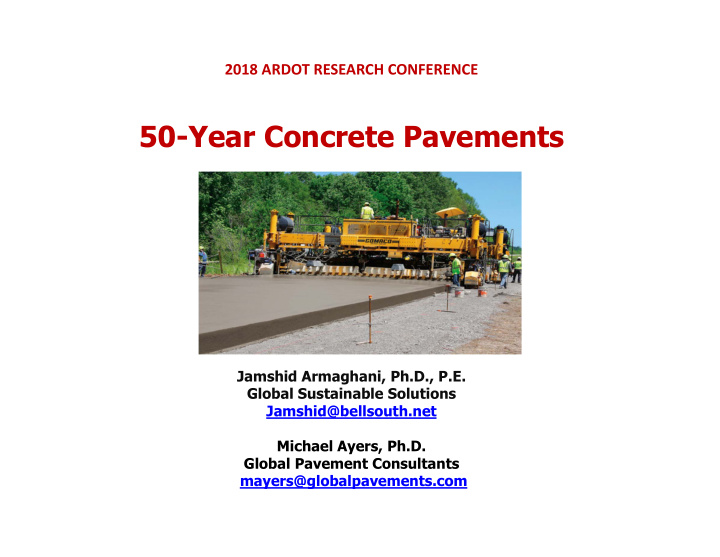



2018 ARDOT RESEARCH CONFERENCE 50-Year Concrete Pavements Jamshid Armaghani, Ph.D., P.E. Global Sustainable Solutions Jamshid@bellsouth.net Michael Ayers, Ph.D. Global Pavement Consultants mayers@globalpavements.com
150 yrs. 20 yrs. • Tunnels are designed for 150 years. • Bridges are designed for 50 years. Why are pavements designed for 20 years?
Asphalt & Concrete Pavements Both asphalt and concrete pavements are designed for 20 years, based on a 20-year projected traffic. Asphalt is resurfaced after 8-14 years, and, in many cases, carry well below the 20-year design traffic. Most concrete pavements outlast their design life before 1 st rehabilitation, and carry much higher traffic than designed for.
Examples of Long-life Pavements US 1 Whitetopping – 30 yrs. I-75 Tampa – 32 yrs. I-75 Tampa – 32 yrs. US 17 Deland > 75 yrs. Brickell Ave. Miami > 75 yrs .
Factors Contributing to PCCP Longevity AASHTO procedure produces conservative thickness designs. Concrete strength is much higher than specification requirement. Joints are dowelled, joint width is narrower and spacings shorter, and less expansion joints. Uniformly placed and compacted support layers, more permeable. No pumping. More automation and innovations in the construction.
Above factors produce less critical stresses responsible for premature cracking, much longer fatigue life & smoother, quieter pavements. Such conditions ensure long-life concrete pavements requiring minimum, if any, rehabilitation.
It is time to specify 50-year concrete pavements! Reinforced Jointed Precast
50-Year Concrete Pavements: Highest quality pavements. Would require minimum, if any, rehab. in first 30 years of service life. Used in select strategic highways that carry heavy traffic. Initially, would be most suited for DB or PPP projects. Justified higher initial cost based on longevity, cost savings in less rehabilitation, less traffic delays and more accident prevention.
Research Needs/ Dept. Actions Selection criteria for project contracted conventionally or through PPPs Revisions in pavement design utilizing AASHTO ME. Emphasis on design details, accurate traffic projections, base materials selection, and geometric details. Upgrade concrete specifications, and develop concrete mixtures compatible with long–life pavements with emphasis on higher level QA/QC and testing requirement.
Research Needs/ Dept. Cont. Best practices manual for construction, with more emphasis on equipment type and proper operation. Testing protocol for performance related indicators. Example: strength, durability, thickness, bar alignment, texture quality, and surface smoothness. Criteria for qualification of designers, contractors, materials testing services and inspection team on long-life projects. Training program for all project personnel including designers, material suppliers and construction project personnel.
Concrete Mix For Long-life Pavements - Recommended - ≥ 4000 psi 500 – 600 lb w/SCMs Well‐graded total aggregate system. (Shilstone method) ≤ 0.45 W/C Slump 1.5”‐2” (slipform) Shrinkage test & limits Coefficient of thermal expansion test
Design Requirements Design firms to demonstrate high level of experience in designing major concrete pavements The Department would be open and encourage value engineering and innovative, verifiable designs. Pavement thickness, support layer materials and jointing details must produce low pavement stresses, high drainability, long fatigue life and long‐term smooth and quiet surface. Independent review of the design by the Department and/or a third party consultant to assure constructability and long‐term performance.
Construction Requirements Contractors with track record of successful completion of high‐quality concrete paving projects. The Department would allow value added proposals and proven innovative construction methods. Concrete specifications would be modified to require more engineered concrete mixes, not only judged by strength but also shrinkage and thermal properties. More quality control on paving equipment, surface finish, timely joint‐sawing, and pavement curing. Emphasis on field QC tests for concrete, dowel alignment, thickness, and surface smoothness. Protocol for slab replacement and other actions in case of premature cracking or other paving deficiencies .
Quality Issues in Construction of Long-Life Pavements Ensure Proper Placement!
Avoid Mix Segregation During Paving Cohesive mix discharged from a low altitude
Stringless Control System of Paving Machine
Stringless Paving
QC of paving machine with dowel/tie bar implants to avoid misalignment mishaps
Dowel Alignment Evaluation – MIT Scan
Surface Profile Measuring Device
Proper Curing • Apply as soon as texturing is complete. • Complete and full coverage of surface and sides. • Avoid using hand held sprayer. • Spray water intermittently for 1st 48 hours.
Maturity Device to determine joint sawing time
Narrow vs. Wide Joints Narrow joints ≤ ¼” produce Joints > ½” generate noise for life quieter pavements
50-Year Concrete Pavements The concept is a change in mindset. Represents more awareness to quality. Encourages better training for project personnel in design, construction, testing and inspection. Demands overall quality of construction practices. Produces sustainable and resilient pavements. Can be cost effective with time.
Recommend
More recommend